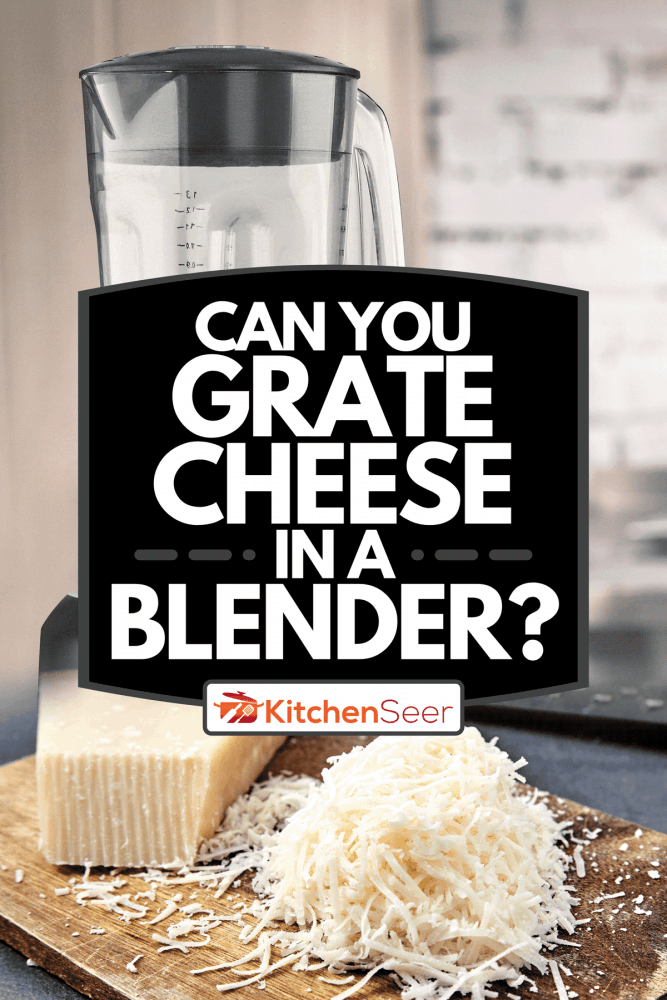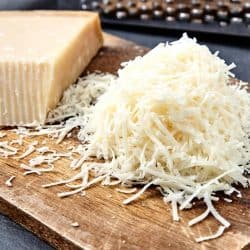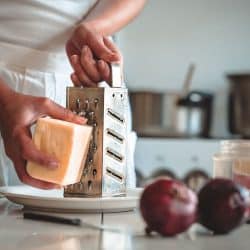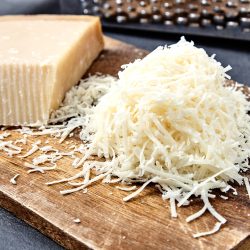You are probably wondering if you can grate cheese in a blender. We have researched all about whether or not you can and should grate cheese in a blender.
You can grate cheese in a blender. Some of the best types of cheeses to grate are hard cheeses such as parmesan or gouda. With soft crumbly cheese, you will not need a grater or a blender. Blue cheese and feta are good examples of cheeses that do not need to be grated because they can easily be broken up in your hands.
Keep reading to learn more about grating cheese in a blender. You will find out if you can grate cheddar or parmesan cheese in a blender, what cheeses work best in a blender, and how to shred cheese in a blender. In case you are curious, we've also covered whether or not it is better to grate your own cheese, and the difference between shredded cheese and grated cheese.

How to Grate Cheese in a Blender
Cut the cheese into small chunks prior to putting it in your blender. To grate or shred cheese in your blender, use a medium to high setting. Stop periodically until you reach the desired texture you are going for. The length of time depends on how hard the cheese you have chosen is.
Click here to see the NutriBullet Blender on Amazon.
There are blades specifically made for grating. You can shred cheese in your blender by using the shredding disk. Another method of grating cheese without a grater is with an electric knife or very sharp kitchen knife.
Check out this YouTube video to see how grating cheese in a blender works.
Types of Cheese and Their Hardness Level
There are three main categories when it comes to classifying cheese. These categories are defined as hard, semi-hard or firm, and soft. Because it works out better to grate hard cheeses, we thought a list of the most popular cheeses and their hardness levels could be useful.
Hard Cheeses:
- Parmesan
- Romano
- Gouda
Semi-hard or Firm Cheeses:
- Cheddar
- Colby
- Provolone
- Swiss
Soft Cheeses:
- Mozzarella
- Muenster
- Brie
- Feta
- Blue Cheese
A few things you need to know are wetter cheeses like Colby and cheddar are also stickier. This is something to consider when choosing to use a blender for grating or shredding. One useful tip is to spray your blades with a layer of non-stick cooking oil or spray. You do this so that whatever cheese you are grating or shredding does not stick to the blades as much.
Something else that is beneficial to know is about blue cheese. When you eat blue cheese raw or a large amount, it ends up tasting very salty.
Can you grate any type of cheese?
You can potentially grate any type of cheese. For softer cheese like mozzarella, you will want to freeze it for 15 to 20 minutes prior to grating it. This makes the cheese harder. Placing your cheese in the freezer before grating it will help you achieve a better result. You do not want the cheese to completely freeze, just harden.
Cheddar cheese is considered to be semi-hard or firm, but it is still a good rule of thumb to put every type of cheese that is not said to be hard cheese in the freezer for a short time prior to grating it.
Can you grate cheddar cheese in a blender?
You can grate cheddar cheese in a blender or with a cheese grater. There are accessories for this specific action such as blades made for grating. Some even have a grating side and a shredding side.
Can you grate Parmesan cheese in a blender?
Parmesan cheese is one of the best cheeses to grate. Fresh parmesan is more flavorful than the kind you buy that is already grated. It is also less expensive to grate cheese from a block of cheese rather than buying it grated.
It is suggested to grate one cup of cheese or less at a time. To grate parmesan cheese, cut the block into one to two-inch-sized pieces first. Then add the cubes of cheese to your blender and grate the cheese until it becomes the consistency that you desire.
How do you shred cheese in a blender?
In order to shred cheese in a blender, you can use a blade specifically made for shredding. It is better to use a box grater or Microplane to shred your cheese, aside from blending.
The box grater below is made of stainless steel. It comes with a container box to collect your grated or shredded cheese. It also comes with a protective glove!
Click here to see the Ourokhome Box Grater on Amazon.
Other than a blender and box grater, a Microplane rasp is great for shredding cheese. This one even comes with an anti-bacterial cover and a storing case. It also has a non-slip handle and is dishwasher-safe.
Click here to see a Microplane Rasp Grater on Amazon.
One type of blender that you can get a shredding blade for is the Ninja Foodi Power Blender and Processor system.
Click here to see Ninja Foodi SS351 Power Blender & Processor System.
Is it better to grate your own cheese?
Not only is it less expensive to grate your own cheese it also tastes better when you grate your own cheese. Grating your own cheese gives you fresh cheese for your meal which is more flavorful rather than buying it already processed.
When you grate your own cheese, it does not have preservatives. Preservatives make the grated cheese you purchase in a bag at the store not stick together. This is the main reason fresh cheese tastes better than processed cheese too. You get a larger quantity at the same price point when you grate your own cheese as well.
Another reason it is better to grate your own cheese is that it melts better. The preservatives and additives in bagged cheese also contain additional starches. Those additional starches prevent it from melting as well as when you grate your own cheese.
What's the difference between grated and shredded cheese?
There are a few differences between grated cheese and shredded cheese. One difference is the way they look. Another difference is what they are used for. Some cheeses are better to grate, and others are better to shred.
Grated cheese results in smaller pieces of cheese than shredded cheese. Grated cheese is finely shredded. It is more practical to think of it as if grated cheese can be sprinkled over food. Shredded cheese can be picked more easily as it is more like strips of cheese.
In Closing
In essence, you can grate cheese in a blender. It is best to use a shredding or grating blade. Softer cheese such as cheddar and mozzarella are sticker, so you will want to coat the blades of your blender in non-stick cooking spray or oil. Remember to place softer cheese in the freezer before grating them.
Before you go, check out the following links to learn more about cooking with cheese:
Can You Microwave Brie Cheese?
What Kind Of Knife Is Best For Cutting Cheese? [6 Options]
How to Grate Parmesan Cheese Without a Grater [5 Options Revealed]





![Parmesan cheese layed on chopping board for slicing with greens on the side, How to Grate Parmesan Cheese Without a Grater [5 Options Revealed]](https://kitchenseer.com/wp-content/uploads/2020/04/Parmesan-cheese-layed-on-chopping-board-for-slicing-with-greens-on-the-side-1-250x250.jpg)


![A grater with a lemon zest on a table and a collage of different types of graters, 12 Types of Graters [and How to Use Them]](https://kitchenseer.com/wp-content/uploads/2020/04/12-Types-of-Graters-and-How-to-Use-Them-Featured-250x250.jpg)
![set of cheese knives on a round wooden board. 14 Types Of Cheese Knives [Inc. What Cheese They're Good For And Why]](https://kitchenseer.com/wp-content/uploads/2021/07/set-of-cheese-knives-on-a-round-wooden-board.-14-Types-Of-Cheese-Knives-Inc.-What-Cheese-Theyre-Good-For-And-Why-250x250.png)
